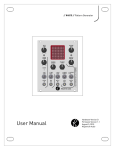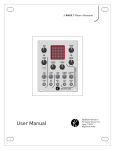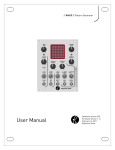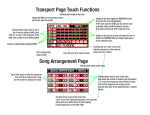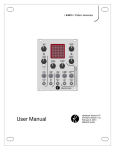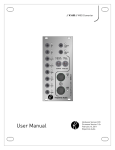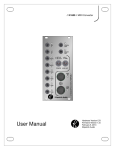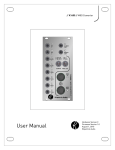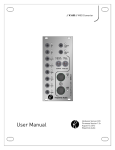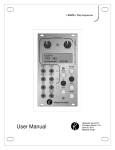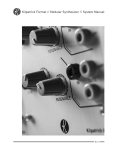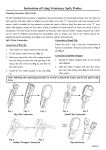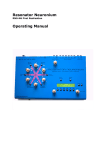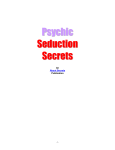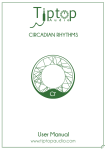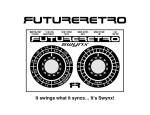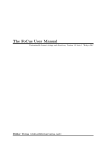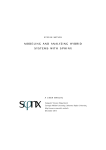Download K4816 User Manual - Kilpatrick Audio
Transcript
// K4816 // Pattern Generator User Manual Hardware Version A / E Firmware Version 1.0 / 1.2 April 4, 2011 Kilpatrick Audio // K4816 // Pattern Generator 2p Introduction Welcome to the wonderful world of the K4816 Pattern Generator, the Buchla version of the popular K4815 Pattern Generator for Eurorack. The K4816 is a unique and flexible way of generating notes, rhythms and modulation voltages or control changes. The user interacts with the machine to set the patterns using an unconventional method which works well to find new grooves and musical inspiration. It is a perfect performance tool, a source of notes for jamming, or a way to creating voltages synchronized to a common clock. This manual will explain the features and operation of the unit. Please check for updates to the documentation and firmware often as new features may be added at users' request. We continually strive to advance our products for your benefit and enjoyment. The K4816 builds on the success of the K4815 but offers a number of new features such as voltage control of various parameters, an enhanced clock system, the ability to generate MIDI CC and clock messages from analog voltages, and a built-in MIDI interface. Features • • • • • • • • • • • • • Buchla form-factor with 7” height, 1 space (4.25”) wide Musical note, control and clock signals generated using unique methods 64 LED (8x8) multi-brightness grid to show patterns and status Clock control via internal clock, or external MIDI or analog clock Clock, Direction, Start, Continue and Stop inputs (10V pulses, or 10V held for Direction) Motion Start, Motion Length, and Pattern Type CV inputs (0-10V range) Offset Input actively mixes (analog) with CV/X output for transposition or modulation CV/GATE or X/Y analog outputs (0V to 10V range) CV is 1.2V/octave – 8 octave range GATE supports Buchla-style trigger pulse / sustain waveform for controlling 281e, etc. Built-in MIDI input supports note, CC and clock control over MIDI Built-in MIDI output to drive synths and sequencers, and use as a CV to MIDI interface Comes equipped with a Buchla power cable – requires +15V, -15V and +5V for operation User Manual Hardware Version A / E Firmware Version 1.0 / 1.2 April 4, 2011 © 2011 Kilpatrick Audio // K4816 // Pattern Generator 3p Installation and Setup When installing the K4816 in your modular system, make sure that you check and connect the power cable carefully and correctly. Wrong installation could damage this or other modules. The warranty does not cover damage caused by wrong installation. There are internal cables and adaptor boards installed during assembly. Never disconnect or alter the on-board wiring as this could cause damage to the module. The K4816 Pattern Generator supports both MIDI and control voltage/gate/clock signals. The built-in MIDI functions are available on the front-panel MIDI ports. To set the MIDI channel, tap the MIDI learn button and send a note or CC message within a few seconds. The unit will switch to the new channel. The learned channel will be stored in internal EEPROM and survives power cycling. User Manual Hardware Version A / E Firmware Version 1.0 / 1.2 April 4, 2011 © 2011 Kilpatrick Audio // K4816 // Pattern Generator 4p Output Voltage Trim The voltage trim on the outputs is factory calibrated into a 100K ohm load. But depending on your setup you might need to adjust it if the scale tuning is wrong with your oscillators. The multi-turn trim pot supplied on each output can adjust the tuning over a significant range. To trim the outputs it is recommended that you set up a pattern consisting of octaves played in the large scale span. You can adjust the trim pots until the notes play in tune. Output Voltage Trim: Adjust the output voltage trim with a small flat screwdriver to achieve the correct scale span with your VCO. R32 = CV/X trim R33 = GATE/Y trim Output Voltage Trim Physical Installation You should install the unit in your modular system using all four screw holes. The unit is designed to be mounted properly to avoid damage to the internal parts when plugging or unplugging cables, or adjusting the controls. Connection Warnings All inputs are designed for 0V (off) and +10V (on) or proportional 0-10V control. The inputs are tolerant of any voltage from -15V to +15V, however using only 0-10V signals is recommended. The cv/x and gate/y outputs are analog outputs driven by amplifiers. They have a low output impedance and thus should not be driven by external sources. Please use them as outputs only, and mix them using proper buffered mixing circuits and not by passive multiples or Y-cords. They are short-circuit protected but may be damaged by the external input of voltages. Do not short the outputs or connect them to any other source of voltage! The Offset In jack has been provided to allow buffered mixing of external signals with the cv/x signal. Internally a buffered 1 + 1 mixer is used to add the Offset In signal with the cv/x output from the K4816. User Manual Hardware Version A / E Firmware Version 1.0 / 1.2 April 4, 2011 © 2011 Kilpatrick Audio // K4816 // Pattern Generator 5p First Use Connect the CV and gate outputs to a VCO CV input and an envelope generator gate input and let's make some sound! The K4816 has a built-in clock generator so you can create patterns without any external clock source. Flip the int/ext switch up to use the internal clock mode. The CLOCK SPEED control affects the tempo when in internal clock mode. The CLOCK LED pulsates once per beat. Note that in internal clock mode, the notes operate at 4x the clock rate. (16th notes) In the external mode this is adjustable, as you will see later. Make sure the cv/gate / x/y switch is up. (cv/gate mode) Choose a motion type by turning the MOTION TYPE knob. This selects the motion of the playback ball. Turn up the MOTION LENGTH knob to maximum to play every step in the motion sequence. Adjust the pattern type with the PATTERN TYPE knob to select where notes will play. You should hear notes being generated as the playback ball lands on active notes on the grid. Using the maj/min and large/small switches, you can choose from major or minor tonalities, as well as large and small output spans. The GATE TIME knob affects how long each note plays, and the MOTION LENGTH knob affects how many of the up to 64 steps in each motion sequence will play before repeating. Play around with the controls and hear some of the different possibilities. The next section will cover each control in more detail, as well as a more overall discussion of how the K4816 makes patterns based on the settings that you have selected. User Manual Hardware Version A / E Firmware Version 1.0 / 1.2 April 4, 2011 © 2011 Kilpatrick Audio // K4816 // Pattern Generator 6p Pattern Generation Concept The pattern generator concept employed in the K4816 is one that can be thought of as three separate layers of control. The layers are as follows: • • • Scale – The scale is the very lowest layer. The notes mapped to each location on the 8x8 grid are set by the chosen scale. Where in most sequencers the notes are assigned by the user, the K4816 fixes the notes to the grid locations. You can choose either major or minor tonality, as well as large or small scale span. This may seem like a limitation, but it's not as you will soon see. The scale mappings are shown below. Pattern Type – The pattern is set with the PATTERN TYPE control and is shown on the background of the LED grid at all times. It defines which notes on the grid will play as the playback ball moves around the display. If a note is lit, it will play. The pattern defines the overall sound of playback, and can also affect how sparse or dense the pattern is. Motion Type – The motion is set with the MOTION TYPE control. The motion type defines how the playback ball will move around the grid during playback. A motion contains up to 64 steps, each of which can move to any position on the 8x8 grid. If the ball lands on a grid location which is lit by the pattern, the underlying scale note will play, otherwise the previous note will keep playing. (depending on the GATE TIME setting) The combination of settings for the motion type and pattern type offers an incredible array of rhythmic and melodic sequences. User Manual Hardware Version A / E Firmware Version 1.0 / 1.2 April 4, 2011 © 2011 Kilpatrick Audio // K4816 // Pattern Generator 7p Advanced Operation To provide more in-depth detail of the controls and how to make the most of the machine, this section goes into detail on each aspect of the system. Internal Clocking and Timing Using External Clock The machine uses a 24ppq internal timebase. The clock can be supplied by MIDI timing ticks, by an analog clock input signal, or by the internal clock generator. The analog clock triggers on the rising edge and can support clock rates up to approx. 100pps. (250bpm) Each clock pulse input accounts for 1/24th of a beat. When using external clock mode you can adjust how many clock pulses are required to advance the pattern one step. These are set by the CLOCK SPEED pot and range from 1-24 pulses per step. The supported divisions allow: 1, 2, 3, 4, 6, 8, 12 or 24 notes per beat. (24 ticks) The division is only changed at the end of a beat (24 internal counts] to prevent jumpy behaviour. When external clocks are input either by MIDI or by the analog clock input, MIDI clock pulses are transmitted on the MIDI OUT port. In this way you can convert analog clock signals to MIDI signals. Note: Using MIDI and analog clock at the same time may produce undesired results. To prevent stuck notes in the case of external clock loss, playing notes are automatically killed if no clock signals are received for 10 seconds. Using Internal Clock When using the internal clock mode, the CLOCK SPEED pot sets the tempo. In this mode the pattern always advances four steps per beat. (16th notes) The tempo generated by the internal clock can range from approx. 19 to 400bpm. When using the internal clock mode, MIDI clock is automatically transmitted. If the CLOCK SPEED pot is turned all the way down the clock will be stopped. Clock LED The clock LED will pulse for a short time at the beginning of every beat (internal or MIDI clock mode) or whenever an external clock pulse is received on the clock input jack. GATE TIME Control When notes are played, the GATE TIME control affects how long the notes will play. When in the minimum setting, the note will play for 1 internal clock tick. At the maximum setting, the note can play for more than two full beats. Note that this control scales automatically with the tempo. Some synthesizer patches might be barely audible if the gate time is short and the tempo is high. User Manual Hardware Version A / E Firmware Version 1.0 / 1.2 April 4, 2011 © 2011 Kilpatrick Audio // K4816 // Pattern Generator 8p Fwd/Rev Control and Dir Input While any motion is playing, the direction can be reversed by adjusting the fwd/rev switch. It can also be reversed by an external voltage. If a voltage is placed on the dir input jack, the current direction of the pattern will be reversed. The direction can also be changed by using the MIDI CC #64. (damper pedal) When the damper is pressed down, the direction will be reversed. Reset Control You can reset the playback position of a motion at any time by pressing on the MOTION TYPE knob. You can also reset the playback position by inputting a pulse into the start jack. Note that the position is reset only once each time the knob is pressed or a pulse is received. This works even when the clock is stopped. The next note to play after resetting when the clock resumes will be the first note in the pattern. This is similar to the "reset to 16th note" on some sequencers, however in this case the effect is the same without requiring any special settings. Output Mode via the CV/Gate / X/Y Switch Normally the cv/gate / x/y switch is in the cv/gate mode (up). In this mode notes are generated as CV and gate on the output jacks, and MIDI note messages are sent on the MIDI bus. In the x/y mode (down), the CV and gate jacks output signals which are related to the absolute playback ball position on the LED matrix. This can be used for modulation or other uses of varying voltages. The X output sends the horizontal position and the Y output sends the vertical position. The MIDI output sends continuous controller (CC) messages for the X and Y positions also. These are shown in the MIDI Implementation section of the manual. Note that the outputs in X/Y mode are stepped and if you want continually varying voltages you will need to pass them through a glide processor. Maj/Min and Large/Small Switches The underlying notes which are used for playback are selected with the maj/min and large/small switches. As the melodic and rhythmic patterns are based on a wide variety of patterns and motions, the underlying notes are kept purposefully simple. The maj/min switch chooses major (up) or minor (down) scales. The minor scale used is the natural minor. The large/small switch affects how many octaves are mapped onto the grid. In the small mode (down) there are two octaves. In the large mode (up) there are four octaves. In the x/y output mode the large/small control affects the size of the output signal. Either small (down) or large (up) range of control. Experiment with the outputs on either analog or MIDI to see how this affects your other equipment. The maj/min switch inverts both the X and Y signals in case you wish to have an opposite voltage output. User Manual Hardware Version A / E Firmware Version 1.0 / 1.2 April 4, 2011 © 2011 Kilpatrick Audio // K4816 // Pattern Generator 9p Major Scale The major scale spans from C to C without any output offset applied. Notes are mapped from left to right on each row. Every column has the same notes, but different octaves depending on the setting on the large/small switch. Minor Scale The minor scale spans from C to C without any output offset applied. The natural minor is used. (flattened third, natural 6th and 7th) Every column has the same notes, but different octaves depending on the setting on the large/small switch. Large Span In the large span mode, four octaves are used. These go from low on the top row, to high in the fourth row. The scales then repeat on the lower half of the grid. Small Span In the small span mode, two octaves are used. The lower octave is on rows 1, 3, 5 and 7. The higher octave is on rows 2, 4, 6 and 8. Scale Mapping (All Modes) C D E F G A B C C D E F G A B C C D E F G A B C C D E F G A B C C D E F G A B C C D E F G A B C C D E F G A B C C D E F G A B C User Manual Hardware Version A / E Firmware Version 1.0 / 1.2 April 4, 2011 © 2011 Kilpatrick Audio // K4816 // Pattern Generator 10p OUTPUT OFFSET Control In cv/gate mode, the OUTPUT OFFSET control affects the transposition of the note outputs on CV and MIDI. You can shift the notes up or down by semitones. A full 8 octave range is possible. In x/y mode, the OUTPUT OFFSET control affects the DC offset of the X and Y signals. You can use this control to get the varying signal into the right range for your equipment. The span of the x/y output is 2.5V to 7.5V, so you can shift this up and down. PATTERN TYPE Control The PATTERN TYPE control selects from one of 32 internal patterns which display on the background of the LED matrix and determine which of the underlying scale notes will play when the playback ball lands on them. There is a range of geometric and other special patterns to choose from, all of which provide different kinds of notes and rhythms depending on the motion type used. There is also a pattern with every note enabled which may be useful for testing and hearing different motion patterns and scales in their entirety. User Manual Hardware Version A / E Firmware Version 1.0 / 1.2 April 4, 2011 © 2011 Kilpatrick Audio // K4816 // Pattern Generator 11p MOTION TYPE Control The MOTION TYPE control affects how the playback ball moves around on the display. Each motion type can have up to 64 steps. Each of these steps can land on any position on the grid, and positions can be visited twice, so quite complex motions are possible, not just sequential patterns. There are 64 motion types which are selected by using the MOTION TYPE control. Pressing on the control resets the motion playback position to the first step. When you change motion types, the selected motion is shown on the display briefly in the form of two intersecting lines. The horizontal line represents the row, and the vertical line represents the motion number from 1-8 along that row. This allows all 64 motions to be shown by the intersection of two lines on the grid. The MOTION TYPE can also be set via MIDI program change. Patches 1-64 select the 64 motions available from the front panel of the machine. Patches 65-128 select the same patches but in "key trigger" mode, meaning that the motion will only play when MIDI note messages are received (keys pressed) on a MIDI keyboard. This allows the machine to work as an auto-arpeggiator. There are some special motion types which are not pre-programmed, but instead are set randomly. These allow either continually changing random motions, or random motions which are seeded each time the motion is selected, so that repetition of the motion is possible. Preset Motions Preset motions are available from patches 1-48. These are hand-generated by several collaborators and contain simple linear motions, as well as more complex motions. Motions are up to 64 steps long, but some are less than this based on the particular design concept. Some are visually designed and others are musically designed, taking into account the underlying scale notes to create melodic and arpeggiating patterns. Random Motions In addition to the 48 preset motions, there are also 16 random motion types in locations 49-64. These are algorithmically created in real-time using a pseudo-random number generator. There are two random motion types with up to eight variations possible for each. See the list below for the variation types. • • Seeded Random – All 64 possible steps are seeded with random values once. Subsequent playback causes the same motion to be repeated. Totally Random – Each motion step is generated new every time. This creates a constantly changing random sequence. User Manual Hardware Version A / E Firmware Version 1.0 / 1.2 April 4, 2011 © 2011 Kilpatrick Audio // K4816 // Pattern Generator 12p Motion List 1 - Sequential left to right and top to bottom. 2 - Sequential top to bottom and left to right. 3 - Sequential zig zag left/right from top to bottom. 4 - Sequential zig-zag up/down and from left to right. 5 - Jumping from the start. 6 - Crazier jumping from the start. 7 - Spiral 8 - Diagonal zig-zag from bottom left corner. 9 - Skipping zig-zag from bottom right corner. 10 - Up and down triads. 11 - Octave jumping 5ths. 12 - Octave jumping wiggly worm. 13 - Octave jumping rows of four. 14 - Wiggles in different directions. 15 - Preset scatter 1. 16 - Preset scatter 2. 17 - Preset scatter 3. 18 - Ping-pong horizontal mirror reflection. 19 - Cat. 20 - Hanon. 21 - Diagonal zig-zag from bottom right corner. 22 - Diagonal zig-zag ping-pong from bottom right corner. 23 - X circle 24 - Stars. 25 - Ropes and knots. 26 - Squares of different sizes. 27 - Hurricane shape. 28 - C-E-G Triad 29 - D-F-A Triad 30 - C-E-G-B Triad 31 - D-F-A-C Triad 32 - C-E-G-C Triads Up/Down 33 - E-C-C-G Triads 34 - F-D-A Triads 35 - The Sound of Five 36 - Slither 37 - Mini Slither 38 - Mini Slither 2 39 - Crossing Over 40 - Groove 1 41 - Groove 2 42 - Groove 3 43 - Groove 4 44 - Groove 5 45 - Groove 6 46 - Groove 7 47 - Groove 8 48 - Groove 9 49 - Seeded Random - Seconds 50 - Seeded Random - Thirds 51 - Seeded Random - Fifths 52 - Seeded Random - Row 1 53 - Seeded Random - Rows 1 and 2 54 - Seeded Random - 1, 2, 3 and 4 55 - Seeded Random - 1, 2, 5 and 6 56 - Seeded Random - All Notes 57 - Totally Random - Seconds 58 - Totally Random - Thirds 59 - Totally Random - Fifths 60 - Totally Random - Row 1 61 - Totally Random - Rows 1 and 2 62 - Totally Random - 1, 2, 3 and 4 63 - Totally Random - 1, 2, 5 and 6 64 - Totally Random - All Notes MOTION LENGTH Control Each motion type can have up to 64 steps. But it can sound interesting to play fewer steps. By turning down the MOTION LENGTH control you can play from 1-64 of the total steps in the motion. The motions will repeat once the end of the motion (or the current length setting) is reached. User Manual Hardware Version A / E Firmware Version 1.0 / 1.2 April 4, 2011 © 2011 Kilpatrick Audio // K4816 // Pattern Generator 13p Clock Control Inputs The clock control consists of five inputs. They work as follows: Clock Input The clock input is used to provide external clock pulses to drive the pattern generator internal clock. The CLOCK SPEED control adjusts the input clock divider to one of the following: 1, 2, 3, 4, 6, 8, 12 or 24. Note that the divider setting is only updated after a complete beat (24 pulses) are received. This prevents jumpy behaviour while the control is being changed. Dir Input The dir input reverses the current playback direction selected by the fwd/rev switch. Hold a voltage on this input to reverse the direction. Start Input The start input resets the playback position and starts the clock when a pulse is received. It also sends a MIDI start clock message. Continue Input The continue input starts the clock when a pulse is received. It also sends a MIDI continue clock message. Stop Input The stop input stops the clock when a pulse is received. Analog clock pulses, MIDI clock ticks or internal clock pulses can still be received or generated, but the playback will be halted until a Start or Continue pulses (or MIDI message) is received. This also sends a MIDI stop clock message. Note that if you need to restart the clock and no pulses are available, switching the int/ext switch or turning the clock speed down and then up again (in internal mode only) will restart the clock. User Manual Hardware Version A / E Firmware Version 1.0 / 1.2 April 4, 2011 © 2011 Kilpatrick Audio // K4816 // Pattern Generator 14p CV Inputs The motion inputs allow the motion start and length to be controlled by voltages. Motion Start Input The motion start has no front panel control and defaults to starting at the first position in a motion sequence. Applying a voltage from 0-10V to the motion start input will offset the starting position of a sequence from position 1 to 64. Motion Length Input The motion length is usually adjusted by the front panel MOTION LENGTH control. A voltage can be applied to the motion len input to adjust the length. A voltage from 0-10V adjusts the length from 1-64 steps. The voltage will only increase the length from the current value set on the MOTION LENGTH control. For complete voltage control it is necessary to turn the MOTION LENGTH control all the way down. Otherwise the input will simply increase the length as it goes beyond the current front-panel setting. Pattern Type Input The Pattern Type input allows the current pattern to be adjusted by a voltage. Similar to the motion len input, the pattern type input will only increase the pattern type up from the current setting. A voltage from 0-10V will adjust the pattern type from pattern 1-32. For the full range of voltage control turn the PATTERN TYPE control all the way down. Offset Input The offset in allows the cv/x output from the K4816 to be mixed with an external voltage. An active buffer circuit is used to mix the two signals together with a 1 + 1 relationship. For instance, if the pattern generator is making 5V and 5V is input to the offset in jack, the output will be 10V. The mixing is done in the analog domain so signals can pass through the unit unaltered. User Manual Hardware Version A / E Firmware Version 1.0 / 1.2 April 4, 2011 © 2011 Kilpatrick Audio // K4816 // Pattern Generator 15p MIDI Implementation In addition to analog interfaces available from the front panel, the K4816 fully supports MIDI and provides a number of useful functions that are not available on the front panel. It also provides a useful MIDI clock output which can be used as either a stand-alone MIDI clock generator, or as an analog to MIDI clock converter. It also provides clock input via MIDI clock, which can be used instead of the analog clock input. Control change and note outputs are supported, as well as note and controller input for transposing the pattern, using key trigger playback mode, and reversing the direction of playback. MIDI Ports The front panel of the K4816 provides MIDI IN and OUT ports. The MIDI IN jack is used for inputting clock, note and CC messages for controlling the K4816. The MIDI OUT jack is used for outputting generated clock, note and CC messages. Some messages received on the MIDI IN jack will also be relayed on the MIDI OUT jack as long as they are channel voice controls on the currently set MIDI channel. Notes and some other messages are not echoed. Also output on the MIDI OUT jack are the motion start, motion len and pattern type input values. A voltage range of 0-10V produces CC values from 0-127. MIDI Clock Support By sending MIDI clock to the machine while it is in external clock mode, it is possible to synchronize the machine to an external MIDI sequencer or other clock source. The input is divided by the CLOCK SPEED control just as with an analog clock input. When running in any clock mode, MIDI clock is sent to the MIDI output. This means that the machine can be used as a MIDI clock generator (internal clock), or an analog to MIDI clock converter. MIDI clock start, continue and stop messages are also both sent and received and can be used to control the playback of the pattern generator from a computer or drum machine. MIDI Program Change The 64 motion types can be selected by a MIDI program change command received by the machine. Programs 1-64 correspond to the 64 patterns selectable by the MOTION TYPE control. Programs 65128 correspond to the same 64 patterns, except that keyboard trigger mode is enabled. Keyboard trigger mode allows the playback of a motion to be started when a key is pressed, to use the K4816 as a sort of auto-arpeggiator. User Manual Hardware Version A / E Firmware Version 1.0 / 1.2 April 4, 2011 © 2011 Kilpatrick Audio // K4816 // Pattern Generator 16p MIDI Note Support When in cv/gate output mode, MIDI notes corresponding to the ones being sent from the CV and gate outputs will be sent. The note length and transposition are the same as the analog outputs. Notes received by the machine from an external MIDI keyboard will transpose the currently playing notes. Middle C is treated as the default transposition. Any notes higher or lower will shift the note playback by the corresponding number of semitones away from middle C. When one of the patches from 65-128 is selected, notes received by the K4816 will trigger the start of playback at the beginning of the motion sequence. If you play legato, the notes will be transposed, but the motion will continue playing through to the end before repeating. If you play staccato, the motion will restart from the beginning for each note. MIDI Controller Change While in x/y output mode, instead of transmitting MIDI notes, continuous controller messages will be sent. Controllers 16 and 17 correspond to the X and Y values of the playback ball respectively. The large/small switch affects the size of the output, and the maj/min affects the polarity of the output voltages. When MIDI controller 64 (damper pedal) is received the current playback direction is reversed just as with the analog dir input. MIDI CC messages are generated based on the motion start, motion len and pattern type inputs. The mapping is as follows: • pattern type – CC 20 • motion start – CC 21 • motion len – CC 22 Note that the CCs sent are just the sampled value from the input jacks and do not represent the current position of the internal pattern generator state for these functions. You can also send these CC values to the K4816 MIDI IN to adjust these settings as if they were being adjusted by a CV input. MIDI SYSEX Messages A series of SYSEX messages are used for software updating and loading new motions, patterns and scales. Currently this requires software from Kilpatrick Audio and will be sent to owners of the K4816 who request additional or different features or require bug fixes. Please contact Kilpatrick Audio for more information if you would like to experiment with this feature. User Manual Hardware Version A / E Firmware Version 1.0 / 1.2 April 4, 2011 © 2011 Kilpatrick Audio // K4816 // Pattern Generator 17p Support and Additional Information Please contact Kilpatrick Audio with additional questions about the K4816 Pattern Generator. We will do our best to help you make the most of your product and welcome your suggestions as to software improvements or ideas for features on new products. Contact: [email protected] User Manual Hardware Version A / E Firmware Version 1.0 / 1.2 April 4, 2011 © 2011 Kilpatrick Audio // K4816 // Pattern Generator K4816 Pattern Generator Function MIDI IMPLEMENTATION CHART ver.1.1 18p 2011-04-04 Transmitted Recognized Remarks 1 (default) 1-16 (configured) 1 (default) 1-16 (configured) Use TEST mode to set the MIDI RX channel. X X X X X X 0-127 0-127 O X Sent at value 100 O O O O Echoed from input Pitch Bend O O Echoed from input Control Change O O Channel mode messages are not echoed 16 = X output 17 = Y output 20 = Pattern Type CV 21 = Motion Start CV 22 = Motion Length CV 20 = Pattern Type 21 = Motion Start 22 = Motion Length 64 = Dir input Prog Change True # X 0-127 0-63 / 0-63 Upper bank has "key trigger" enabled. System Exclusive O O For testing and firmware update only System Common Song Position Song Select Tune Request O X X O X X System Realtime Clock Commands O O O X Aux Messages Local On/Off All Notes Off Active Sensing System Reset X X X X X X X X Basic Default Channel Changed Mode Default Messages Altered Note Number Velocity After Touch Keys Ch's MIDI clock timeout is 10 seconds. Notes Software update specification available upon request. Implemented by Kilpatrick Audio update software as supplied to customers. User Manual Hardware Version A / E Firmware Version 1.0 / 1.2 April 4, 2011 © 2011 Kilpatrick Audio


















